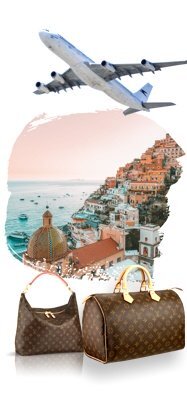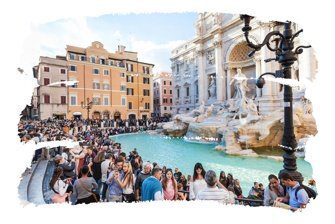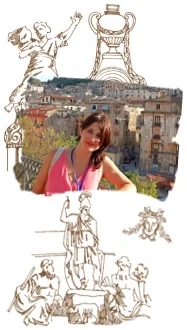How to get to Padua from Venice?
The Veneto region is a fantastic region in northeastern Italy. Cities like Verona, Treviso, Vicenza, Venice, Padua and many others form this region rich in history, gastronomy, culture and with an impressive natural beauty. Today I bring you a super special post that is much requested by my readers: how to go to Padua from Venice? It requires no practice and no skill, just a little bit of attention! Here at Your Travel to Italy with Ana Patricia you make the trip of your dreams !!! ALSO: see our “Accommodation in Italy – Tips for your holidays!”.
Our Introduction
Today we are going to teach you how to get from Venice to Padua: it’s fast, easy and a great option for a day trip. Shall we go to Padua? On our blog we have several super special posts about this fantastic city! To learn more, I invite you to click here to find out all about Padua! And now, finally, we will know how to get from Venice to Padua! Padua is about 45 kilometers away from Venice and offers good transport options ‘back and forth’. Shall we know more?
1) How to get to Padua from Venice? BY BUS
To go to Padua from Venice using the bus, you can take the transport at Piazzale Roma in Venice. From there you will arrive at Padua station and, on the way back, you can take the bus to Piazzale Roma, Venice. Good to know that there is ONLY ONE LINE that operates the stretch, it’s the bus 53E, that is, there’s no mistake!
To come back:
Leaving Padua station, the bus takes Via Tommaseo towards the fair and Stanga and then passes through the centers of Vigonza and Perarolo following Via Venezia, reaching the Riviera del Brenta – from there it goes up to Oriago and also passes through Strà, Fiesso, Solo, Mira. Once in Marghera, it goes straight ahead along Via Fratelli Bandiera to Via della Libertà, and finally arrives at the Venice terminal at Piazzale Roma. It takes exactly the same route from Venice to Padua. The bus leaves every half hour; the journey takes about an hour and a half, and the ticket costs 12 euros. It operates from 4:25 am until 9:55 pm.
Please note special hours:
- During the summer, some timetables may change, as well as some parts of the route, both for departure and arrival from Venice and for departure and arrival from Padua. Therefore, I suggest that you check the timetables and possible changes in the itinerary on the official website of bus operator, which is ACTV and, to check all the timetables, you can click here! TIP: you can access the website and in the blank CERCA, at the top right, just type 53E.
Another option…
Another option is to use the bus that leaves from Venice airport, the Busitalia Veneto (click on the link to see details of timetables, fares and where to buy the ticket). The bus leaves from Marco Polo Airport in Venice and goes to the center of Padua. It costs 4.60 euros if you buy it at the ticket office and 6 euros if you buy it on the bus. The journey takes about 40 minutes. The route is the same as leaving Venice and going to Padua and vice versa.
Advantages
- Ideal option for people who like to do things at their own pace;
- For people who are used to traveling, mainly with public transport;
- For young people and those who are backpacking;
- And especially for people who want to save money and are in no hurry.
Disadvantages
- For families with young children and for elderly people it can be very tiring. I DO NOT RECOMMEND;
- Having to adapt to the fixed timetables of the round trip buses;
- Having to go to the tourist spots alone, without knowing the city or speaking the local language;
- And the time that is lost with all these trips, which could be used to enjoy the visited city more.
2) How to get to Padua from Venice? BY TRAIN
Another excellent option for those leaving Venice. Let’s see the options:
Fast regional line
Regionale Veloce is an excellent, fast, cheap and safe option. The ticket can be bought on the spot and, from Venice to Padua, the journey takes, on average, just half an hour. There are several trains and their departure frequencies vary. The ticket costs 4.35 euros.
Regular regional line
A little more time consuming, but it can be an alternative for those who can’t find the ticket for the fast train. The Regionali are low-speed trains that connect Venice to Padua in a journey that takes approximately 50 minutes. The frequency of departure of trains is between 20 and 60 minutes and the ticket price is also 4.35 euros.
FrecciaRossa
The ‘premium’ line so to speak. FrecciaRossa offers several service levels: Standard, Premium, Business, Business Area Silence, Working Area, Business Salottino and Executive. They are the fastest trains and the journey takes about 25 minutes. There are several departures per day and with varying frequency. The price of the ticket varies between 14.90 and 65 euros and, honestly, I don’t think it’s worth it, as there are other options available for much more reasonable prices, but for those who want it, it’s the option.
Good to know…
- All trains operating between Venice and Padua are accessible for people using wheelchairs.
- Also read our posts about Trains in Italy, click here!
Advantages
- Ideal option for people who like to do things at their own pace;
- For people who are used to traveling, mainly with public transport;
- For young people and those who are backpacking;
- And especially for people who want to save money and are in no hurry.
Disadvantages
- For families with young children and for elderly people it can be very tiring. I DO NOT RECOMMEND;
- Having to adapt to the fixed timetables of the round trip trains;
- Having to go to the tourist spots alone, without knowing the city or speaking the local language;
- Time spent on public buses from train stations to places where tourist attractions are located or money you will spend extra on taxis once you reach your destination;
- Another detail worth mentioning: get ready, because usually the trains on the regional railroad are very bad and sometimes very dirty, so don’t get your hopes up! If you use the train, always choose a high-speed train to avoid this type of problem. To understand the differences in trains, see the post I wrote about the difference in trains in Italy;
- And the time that is lost with all these trips, which could be used to enjoy the visited city more.
3) How to get to Padua from Venice? BY CAR
If you have a car and want to get to know Padua, you won’t find it very difficult either. Leaving Venice, use the motorway at the Padova Est A4 exit. Italian roads are VERY well signposted, so you will hardly have any problems. Remembering that there are several routes to get to Padua from Venice: there are half-hour journeys and others that can last up to an hour and a half.
Good to know…
- There are sections subject to toll payment. Want to know EVERYTHING about tolls in Italy? Read our special post: How do tolls work in Italy?
Golden tip
- If you want a complete and detailed itinerary suggestion, ready for printing, you can click HERE or HERE!
Travelling by car in Italy
How about if I give you a rental car option? Are you ready for it? If you are renting a car be sure to read our posts in the section Driving in Italy on the blog Your Travel to Italy. In addition to car itinerary tips, we have everything about signage, tolls, roads and many more tips.
Don’t know where to rent the car?
We have a partner that can help you: Rent Cars! Have you ever thought about renting a car in Italy, without leaving your home? Click on the banner below to learn more! Search, compare and choose!
Important to know
- Also, it is important to know that in tourist cities there are places (historic centers) where PARKING IS PROHIBITED , and it can only be used by people who live there! That’s why it’s important not to go to these places so as not to take unnecessary fines.
- How to understand what these places are? See the post that talks about it, but anyway, another tip for those who are unsure about it, is to park a little outside the center and go downtown on foot or, spending a little more, by taxi or other public transport.
Advantage
- If you are with 2 to 5 people, it is the most economical option! It will be enough to choose calmly the places to visit and leave peacefully! Always have a map with you, or opt for a car with GPS; Not all cars have this option! Oh, and the cell phone can be a problem if you go through a place with no internet signal.
Disadvantages
- Unexpected expenses with parking and fuel that unfortunately cannot be calculated, but this is normal; in my opinion, the biggest disadvantage is the lack of knowledge of the territory, which can sometimes result in wasted time to find the main cities, and turn a pleasant trip into a nightmare!
- Generally, those who drive can’t appreciate the beautiful view around, since they can’t take their eyes off the road!
4) How to get to Padua from Venice? WITH A GROUP TOUR
People, this is the BEST option for those who don’t want to worry about the bus schedule, about the fact of “calculating” if there’s time to go and come back, don’t want a headache with possible delays, anyway … For those who just want to enjoy the beauty of this incredible place with safety, comfort and tranquility! The group tour is a perfect solution for those who don’t want to spend that much (with a private tour, for example), for those who don’t like to travel alone or for those who don’t like to drive (or can’t).
Click on the link below without commitment!
Advantages
- IDEAL option if you are alone, as a couple or with up to seven friends;
- You will meet new people, make friends and get to know places safely. You will understand all the explanations and will spend unforgettable moments;
- You can enjoy a “bicchiere di vino” (wine drink) during lunch without having to worry about driving afterwards :), as in Italy the laws are strict against those who drive after drinking (even a small amount of alcohol) ;
- In addition to saving on the transport you would spend to get to the train station (or hotel), you won’t need to take a taxi with absurd values and you won’t even have to worry about trying to find your way around the city;
- And, last but not least, you’ll save the time you would have wasted moving around in buses, trains or taxis.
Disadvantage
- If your hotel is not in the center, your only “concern” will be to show up fifteen minutes in advance at the agreed location.
Important
- Remember to always check customer testimonials before proceeding with the booking.
5) How to get to Padua from Venice? PRIVATE TRANSFER
If you don’t want to rent a car or use public transport: talk to me! I have great indications of transfers for your trip to be smooth and pleasant. This is a great option for families with children, people with limited mobility or if you want to have a glass of wine during lunch.
This type of tour is ideal for VIPs, who want to enjoy the trip from start to finish, for small groups of friends or for seniors. This type of service guarantees absolute comfort for those who travel. Basically it’s enjoying the tour without the stress of meeting train, subway, bus timetables, without worrying about where the main places to be seen are!
Advantages
- IDEAL option if you are a couple or with up to seven friends;
- It’s safe, comfortable and you make your own schedule;
- You can enjoy a “bicchiere di vino” (wine drink) during lunch without having to worry about driving afterwards :), as in Italy the laws are strict against those who drive after drinking (even a small amount of alcohol;
- Great for discovering more places in the same day, at your own pace;
- No need to stick to timetables and itineraries;
- You will save a lot of time, which you would lose with traveling by bus and train.
Disadvantage
- The value is a little higher, but a worthwhile investment! Especially if you like to do everything on your own time.
Click here and ask for a free quote!
A little more about Padua…
Padua is the third largest city in terms of population in the Veneto region, behind only Verona and Venice; Padua has around 407,000 inhabitants and is impressively charming. The city was one of the cultural capitals of the 14th century and has incredible historical heritage, especially in the artistic field. Its artistic heyday was in the 14th century; responsible for this splendor was the lordship of the Carraresi, who made the city a true cultural center. In Padua, between the 14th and 15th centuries, a cultural thread dedicated to antiquity was created, which, together with Florence, became a kind of cradle of the Renaissance, but was called the Paduan Renaissance. This influenced many artists from across northern and northeastern Italy in the 15th century. It is worth remembering that, since 1222, Padua has been the seat of an important university that appears on the list of the oldest in the world, the University of Padua Studies.
About the Church of Saint Anthony of Padua
The city is also the episcopal seat that is at the head of one of the largest and oldest dioceses in Italy: the church of Saint Anthony of Padua. Famous Portuguese Franciscan, born in Lisbon in 1195, he lived for a few years in Padua and died there, on June 13, 1231. It is possible to visit the mortal remains of the saint that are preserved in the Basilica of Sant’Antonio, which is an important destination pilgrimage site for Christianity and a true postcard of the city. Saint Anthony is one of the four patron saints of the city which also include: Giustina, Prosdocimo and Daniele.
In 1829, Padua received the first seat of the first rabbinical boarding school which was an important institution of Italian Judaism. Historic indeed! As early as 1524, the Loggia Cornaro was erected in Padua and on February 25th, 1545, a company of comedians was legally formed with notary deed: it was the first witness in the world of a company of professional comedians and marked the symbolic birth of Commedia dell’ Arte (‘Art Commedy’). One of the best examples of this type of art is the classic “The Taming of the Shrew”: the famous comedy written by the hands of the incredible William Shakespeare takes place in the city of Padua.
The Canals of Padua
What few people know is that Padua is also surrounded by canals, as is its neighbor, Venice. In the past, these waterways were essential for the city’s economy, as they served as links to the numerous mills in the region; it also served, of course, to link the city to other cities in Veneto. The river engineering works in the area were carried out by order of the Water Authority of the Republic of Venice, and made it possible to reduce the risk of floods that affected the urban area of the city. Today the complex system of connections and locks between the city’s canals manages to manage and drain even significant floods, nullifying any threat to the city; however, when the waters rise too much, some areas such as Terranegra and Paltana are not completely dry.
Watch this video and discover a little more about Venice!
Subscribe to our channel and receive more videos with information and tips about Italy. Don’t forget to leave that Like;)
Conclusion
How to get to Padua from Venice? If you are in Venice and want to discover a charming, elegant, delightful and charming city, include Padua in your itinerary! Rest assured that the city will surprise you!
Are you insecure?
And if you feel insecure, have no time, and need help to organize your trip, don’t hesitate to contact me! I will love to help you make your dream trip to Italy come true. And how can I do that? Keep reading this post until the end and you will understand how we make your life and your trip much easier.
Did my post help you? If so, be sure to post your comment below, but if you still have questions just send me a message I will answer you as soon as possible!
An Extra Help for your Trip The best content from Your Travel to Italy! Learn more about our tours in Italy right now! Best regards from Italy






 Save money!
Save money!